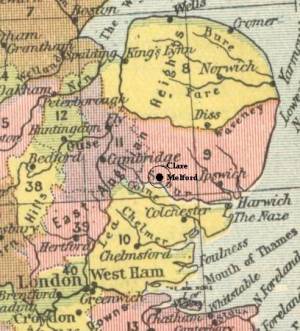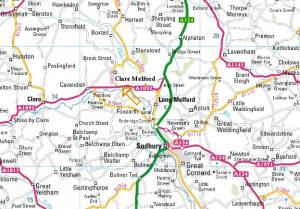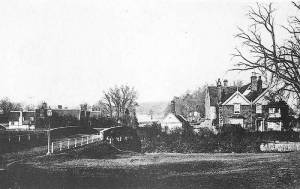Table of Contents
Clare Melford
 According to Delia Hartston, a small Suffolk village where Alexander Roby claimed that 'nine teeth', of great beauty, had been erected for some undefined event of great significance due to take place in December of 1925.
According to Delia Hartston, a small Suffolk village where Alexander Roby claimed that 'nine teeth', of great beauty, had been erected for some undefined event of great significance due to take place in December of 1925.
The investigators arrived in Clare Melford on December 10th, 1928 and visited the Railway Tavern. In conversation with the locals, including landlord Dick Blair, they heard the story of the 'night of the curse', New Year's Eve 1925, on which five locals died mysteriously in their beds. The victims were four elderly people and a young child.
They were also told about nearby Springer Mound, on Harold Jennings' property, which Saunders and Browne visited the following day. There they appear to have found the 'nine teeth' - granite standing stones thought to have been brought up to the hill by Lawrence Bacon and his entourage.
Upon returning to the village at the beginning of December, the investigators found that the stones had been removed from Jennings' property one night a couple of weeks earlier and taken away in a couple of trucks. At least one of the stones was later found to have been re-erected near Loch Mullardoch.
Local History
 Andrew Saunders has researched the history of the Clare Melford Area.
Andrew Saunders has researched the history of the Clare Melford Area.
Clare Melford
Clare Melford is a tiny village midway between Clare and Long Melford. It comprises of a single pub and a few residential homes. It is in the parish of Long Melford. There is no history of interest specific to it - nothing supernatural or any mention of a stone circle, apart from the standard East Anglian ghost stories, in which ghostly dogs such as the hideous Black Shuck are a local specialty.
Clare, Suffolk
Clare is a small town lying on the north bank of the River Stour in Suffolk, England, 22 km from Bury St Edmunds and 14 km from Sudbury.
Lying on an ancient road from Dunwich in East Anglia into the Midlands, Clare contains a large double-ditched “camp” which probably marks the first permanent settlement in the area. This location ensured Clare's importance, which continued after the Norman Conquest, and a castle was built south of the “camp” on a high motte overlooking the town. The keep and parts of the inner and outer baileys still exist, and the castle is part of the Clare Castle Country Park, which contains the only railway station built within a castle in the UK, though it is now decommissioned. The town and castle were given to Richard Fitz Gilbert, Earl of Brion in Normandy, whose lands became known as the 'Honour of Clare', and Fitz Gilbert called himself the Earl of Clare.
Established by Richard de Clare, Earl of Gloucester in 1248, Clare Priory is the first house of Augustinian Friars in England. Lying next to the Clare Castle Country Park, the Priory is still used as a retreat centre.
The late 15th-century parish church of Saint Peter and Saint Paul is one of the most beautiful churches in East Anglia.
Long Melford
 Long Melford, more generally known as Melford, is an ancient village in Suffolk, England, on the border with Essex. The border lies along the banks of the River Stour. Long Melford is approximately 16 miles from Colchester and 14 miles from Bury St. Edmunds.
Long Melford, more generally known as Melford, is an ancient village in Suffolk, England, on the border with Essex. The border lies along the banks of the River Stour. Long Melford is approximately 16 miles from Colchester and 14 miles from Bury St. Edmunds.
Long Melford's most unusual feature is the Holy Trinity church, which is large enough to be a cathedral and sports a celebrated stained glass three-hares motif.
Long Melford contains two stately homes called Kentwell Hall and Melford Hall. Both are in excellent repair, having been built from the proceeds of the wool trade in the Middle Ages.